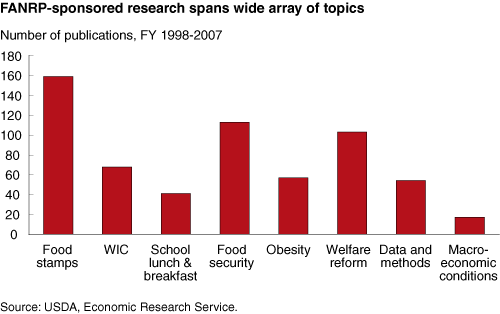Informing Food and Nutrition Assistance Policy
- by Victor Oliveira
- 4/1/2008
Since 1998, Congress has provided ERS with funds to study and evaluate the Nation’s 15 domestic food and nutrition assistance programs. These programs provide participants with food, the means to purchase food, and nutrition education. In recent years, about one in five Americans, at some time during the year, have participated in at least one of these assistance programs, which account for over half of USDA’s annual budget.
ERS established the Food Assistance and Nutrition Research Program (FANRP) to carry out the evaluation. Findings from FANRP studies include the following:
- A 1-percentage-point increase in the Nation’s unemployment rate results in about 700,000 more food stamp recipients during the year following the increase.
- Over half of all new entrants in the Food Stamp Program exit the program within 8 months.
- In 2006, 11 percent of U.S. households were food insecure, including about 30 percent of households headed by single women with children.
These and other FANRP findings have informed public debate on food and nutrition assistance programs. For example, one FANRP-sponsored study found that maternal obesity in early pregnancy more than doubles a child’s risk of obesity at ages 2-4. As a result of this study, a new nutrition risk criterion—“at risk of becoming overweight”—was added to the criteria used to establish participation eligibility in the Special Supplemental Nutrition Program for Women, Infants, and Children (WIC). Low-income infants and preschoolers born to mothers who were obese in early pregnancy are now eligible for nutrition education and WIC-approved foods.
A recent ERS report highlights some of the key research findings from over 600 publications completed during the program’s first decade. The report discusses research on food and nutrition assistance programs’ effects on the diets and economic well-being of needy Americans, how well program benefits are targeted and delivered, and the efficiency and effectiveness of program administration.
The report also discusses research on a number of topics that cut across programs, including linkages with the economy, food security, welfare reform, and childhood obesity. In conjunction with this report, ERS developed an electronic database of all FANRP-supported reports and articles, searchable by topic, title, lead author, and the data used.
This article is drawn from:
- Food Assistance Data & Collaborative Research Programs. (n.d.). U.S. Department of Agriculture, Economic Research Service.
- Oliveira, V. (2007). Informing Food and Nutrition Assistance Policy: 10 Years of Research at ERS. U.S. Department of Agriculture, Economic Research Service. MP-1598.


